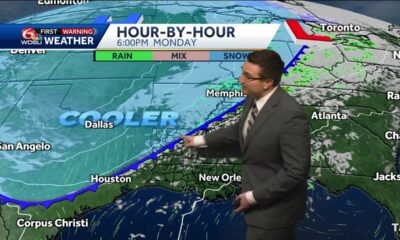News from the South - North Carolina News Feed
March toward normal turbidity continues, as third coagulation treatment is underway for Asheville’s water • Asheville Watchdog
A third round of in-reservoir turbidity treatment started Wednesday at the North Fork Reservoir, as a crucial measurement on the path toward potable water continues to drop.
Water Resources Department spokesperson Clay Chandler said at Wednesday’s daily Helene briefing that the turbidity measurement, Nephelometric Turbidity Units (NTUs), stood at 14.8 in the morning. A week ago it stood at 18.
“So it’s still falling,” Chandler said.
The city is now filtering about 20 million gallons of water a day through North Fork, which provides 80 percent of Asheville’s drinking water, and another 3 million gallons daily through its Mills River treatment plant. That leaves the water department just 4 million gallons a day short of being able to pressurize the entire system. That’s the threshold for again providing potable water, which the city has not delivered since Sept. 27 when Helene washed out the main transmission lines and a backup line, and essentially turned North Fork upside down.
Besides the turbidity treatment, which involves an application of aluminum sulfate and caustic soda in the reservoir to foster coagulation and sinking of clay particles, the city is also moving forward on a partnership with the U.S. Army Corps of Engineers to provide a portable filtration system that can handle high-turbidity water. While ideally the city needs the NTU level to hit 1.5 to 2.0 for optimum water production, the Corps’ system can handle higher NTU.
Regarding the Corps of Engineers “interim pretreatment system,” Chandler said, “the private contractor who will perform the work conducted a site visit Monday afternoon, and equipment and materials started arriving yesterday.”
The timeline for completion of that project remains the same — late November or early December. That depends on the weather, though.
The city has a two-pronged approach to returning to potable water service: continue reducing turbidity while increasing the amount of water that can be filtered, and installing the Army Corps technology to filter more turbid water.
Chandler has said previously that once the city is pushing enough potable water, it will have to flush the entire system and then repressurize it, which could take two and a half to three weeks. Asked if the city currently being able to push through more water than expected, the 20 million gallons per day, could shorten that flushing timetable, Chandler said, “Theoretically, that’s possible.
“But you know, that’s all going to depend on the back-end bacterial testing that we’ll do once that process starts,” Chandler said. “But theoretically, yes, it could speed it up, but that’s no guarantee.”
Potable water’s return still will likely come in early to mid-December. The water continues to clear, and Chandler said Wednesday that is in part because workers are now seeing much finer silt particles instead of the heavy, muddy material they encountered right after the storm, when North Fork turned completely brown.
The city remains under a boil water notice for all residents. The tap water the city is providing is acceptable for showering, flushing toilets and doing laundry, but residents should use bottled water for consumption. If you must use tap water for consumption, it has to be boiled for at least one minute.
Asheville Watchdog is a nonprofit news team producing stories that matter to Asheville and Buncombe County. John Boyle has been covering Asheville and surrounding communities since the 20th century. You can reach him at (828) 337-0941, or via email at jboyle@avlwatchdog.org. The Watchdog’s local reporting during this crisis is made possible by donations from the community. To show your support for this vital public service go to avlwatchdog.org/support-our-publication/.
Related
The post March toward normal turbidity continues, as third coagulation treatment is underway for Asheville’s water • Asheville Watchdog appeared first on avlwatchdog.org
News from the South - North Carolina News Feed
Two women killed and several children hurt in Johnston County crash
SUMMARY: Two women in their 20s died in a car crash in Johnson County, with six children aged under 12 also in the vehicle; one child is in critical condition. The single-car accident occurred at the intersection of Government and Jack roads in Clayton. Investigators report that the driver, speeding about 30 mph over the limit and running a stop sign, lost control, hitting a ditch and a tree before the Jeep Cherokee went airborne. None of the occupants were wearing seat belts, and while alcohol isn’t suspected, the area has a history of crashes.
Two women were killed and several children were hospitalized after an SUV crashed Saturday night in Johnston County.
News from the South - North Carolina News Feed
5 On Your Side Restaurant ratings: Pure Vegan Cafe, Randy's Pizza and Chanello's Pizza
SUMMARY: Inspectors identified food handling and storage issues at several local restaurants. Pure Vegan Cafe in Durham received an 82, down from 91.5, for improper food storage, unclean equipment, and incorrect expiration dates. Randy’s Pizza in Morrisville was rated 86 (down from 94.5) due to employees failing to wash hands after handling personal items, inadequate food temperatures, and fly infestations. Chanello’s Pizza in Garner scored 88.5 (down from 91) after inspectors found expired ingredients, unclean baking trays, and a sticky fly ribbon above the prep sink. Overall, health standards were not adequately maintained across these establishments.
5 On Your Side’s Keely Arthur shows us the problems in this week’s restaurant ratings report.
News from the South - North Carolina News Feed
Man sentenced in 2018 murder of 13-year-old Hania Aguilar tries twice to escape
SUMMARY: Robinson County Sheriff Bernes Wilkins reported heightened security during prisoner Michael McLen’s court hearing. McLen, who pled guilty to the kidnapping and murder of 13-year-old Hana Aguilar and was sentenced to life in prison, made two escape attempts. He first tried using a homemade handcuff key but was stopped by deputies. Returning to prison, McLen grabbed a deputy’s gun during a struggle before being subdued with pepper spray. Eyewitnesses noted his courtroom demeanor seemed insincere, raising questions about potential additional charges from the escape attempts.
Michael Ray McLellan admitted to kidnapping 13-year-old Hania Aguilar from her driveway and then killing her and disposing of her body. The crime happened in November 2018. On Friday, November 22, 2024, he was sentenced to life in prison without the possibility of parole. Investigators say McLellan tried twice to escape from his prison guards — before and after the hearing.
https://abc11.com/post/hania-aguilar-michael-mclellan-guilty-nc-kidnapping-murder-13-year-old-girl-lumberton/15573797/
https://abc11.com/watch/live/11065013/
Download: https://abc11.com/apps/
Like us on Facebook: https://www.facebook.com/ABC11/
Threads: https://www.threads.net/@abc11_wtvd
Instagram: https://www.instagram.com/abc11_wtvd/
TIKTOK: https://www.tiktok.com/@abc11_eyewitnessnews
-

 Local News5 days ago
Local News5 days agoSherral’s Diner to be featured on America’s Best Restaurants
-

 Kaiser Health News6 days ago
Kaiser Health News6 days agoA Closely Watched Trial Over Idaho’s Near-Total Abortion Ban Continues Tuesday
-

 News from the South - Georgia News Feed4 days ago
News from the South - Georgia News Feed4 days agoJose Ibarra found guilty in murder of Laken Riley | FOX 5 News
-

 News from the South - Alabama News Feed4 days ago
News from the South - Alabama News Feed4 days agoTrial underway for Sheila Agee, the mother accused in deadly Home Depot shooting
-

 News from the South - Kentucky News Feed3 days ago
News from the South - Kentucky News Feed3 days agoNicholasville organization activates weather plan in response to bitter cold temperatures
-

 News from the South - Alabama News Feed3 days ago
News from the South - Alabama News Feed3 days agoJudge grants mistrial in Sheila Agee trial due to ‘unhinged juror’
-

 News from the South - Alabama News Feed4 days ago
News from the South - Alabama News Feed4 days agoAlabama's weather forecast is getting colder, and a widespread frost and freeze is likely by the …
-

 Local News2 days ago
Local News2 days agoIntroducing our Student Athlete of the Week: Ocean Springs’ very own Mackenzie Smith























